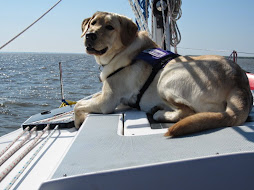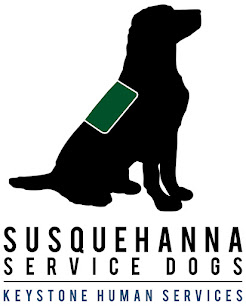Susquehanna Service Dogs Rusty, Shamrock, Lavender, Onyx, Copper, Slate, Jade, Denim and Sienna are dressed for success! Those purple things they’re wearing are puppy-sized harnesses.
All of our service dogs wear harnesses to show that they are a service dog or service dog-in-training. (For SSD, a purple harness means the dog is still in training. A green harness means the dog is a working service dog that has been placed with a partner.) However, having the puppies start wearing them this young is something new for us. If you watched the Hill Top Litter last November, you probably noticed that the puppies did not wear harnesses. With the Crayon Litter, we decided to get the puppies used to their harnesses early. By the time these puppies are grown, they’ll have changed harnesses five times!
We have a very specific reason for dressing the puppies in their harnesses so early. Their mom, SSD Winter, is very sensitive to her harness. If possible, she prefers not to wear it. Harness sensitivity is a trait that the puppies can inherit. We’ve seen it in puppies as young as eight weeks old.
What’s so bad about a dog that’s sensitive to his harness? Nothing is “bad,” really. It does limit the dog’s placement options, though. A dog with harness sensitivity will not be able to be a balance dog because balance dogs wear a special harness that partners hold on to. Also, since the dogs don’t necessarily need to wear their harnesses while they’re at home, partners may need to dress the dog when they go out in public. A dog with harness sensitivity would not be able to be placed with an individual who uses a wheelchair, especially if that person is going to be dressing the dog. It wouldn’t take the dog long to figure out that if he doesn’t want to wear his harness, he just needs to stay out of arm’s reach. A service dog would not be doing his job of assisting his partner to be more independent if that partner has to have someone else put the harness on the dog.
Additionally, dogs that do not like their harness are a little more challenging to train. For example, if a dog doesn’t like his harness, he will tend to do a “sphinx” down rather than a relaxed down, meaning he may hover or not roll onto his hip. Additionally, dogs with harness sensitivity may not like to walk on strange surfaces. Both the relaxed down and walking on strange surfaces are important skills for service dogs.
By having the puppies wear their harnesses at such an early age, we’re hoping they do not develop harness sensitivity. So far, things are looking good!
Here's a video from a few weeks ago of the puppies playing in their harnesses: http://www.ustream.tv/recorded/2308177
Thursday, October 22, 2009
Subscribe to:
Post Comments (Atom)









No comments:
Post a Comment